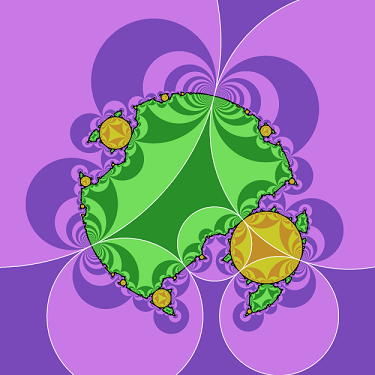I learned from Wikipedia that Gaston Julia died in 1978. Is it known if he ever got to see a computer-generated image of the set named after him?
4 Answers
Not a definitive answer, but a close upper bound.
The same paper that had the first published computer-generated image of the Mandelbrot set also includes an image of the Julia set (no idea if it's the first one too).
The paper is from precisely the same year Julia died, 1978!
The conference was held on June 5-9, at the State University of New York, Stony Brook, and the proceedings were published on 1981.
- Robert Brooks and Peter Matelski, The dynamics of 2-generator subgroups of PSL(2,C), in Irwin Kra (1 May 1981). Irwin Kra, ed. Riemann Surfaces and Related Topics: Proceedings of the 1978 Stony Brook Conference
It is very unlikely that Gaston Julia saw a computer-generated image of a julia set. The first images were obtained at the beginning of the eighties. Note also that this would have been far less interesting and accurate images than the ones that were drawn by hand at the end of the nineteenth century.

Credit: Fricke and Klein, 1897, hosted by Centre national de la recherche scientifique (CNRS)
Compare for example the above hand-drawn image of a limit set (so, something slightly different from a Julia set, but not by far) from the book of Fricke and Klein (1897) with the same image below generated by a modern computer (which could not have been produced with one of these house-sized black and white computers from the times of G. Julia). You can find more details in this online article by M. Audin and A. Cheritat, in French.

Credit: CNRS
-
22$\begingroup$ While computer graphics in 1978 was less advanced, and far less convenient, than it is today, it's not really true that such images couldn't have been produced. There were such things as vector plotters: any good university computer centre would have one, and yes it did have (a limited range of) colours. $\endgroup$ Commented Aug 4, 2016 at 1:34
-
4$\begingroup$ See e,g, hpmuseum.net/display_item.php?hw=79 $\endgroup$ Commented Aug 4, 2016 at 2:55
-
1$\begingroup$ Bitmap displays also existed. Stanford's AI lab had them attached to their PDP-10 timesharing system in 1971; MITs in 1972. The Xerox Alto was an individual workstation in 1973. Printing technology was also available. The Xerox Graphics Printer (XGP) was in use at Stanford, MIT and CMU by 1972, with 192 DPI. Xerox began producing a high-speed laser printer at 300 DPI resolution in 1976. NYIT created a 24-bit color computer display around 1974, and commercial units for broadcast were available by 1975. $\endgroup$ Commented Aug 5, 2016 at 19:15
Quoting from SciAm's article Who Discovered the Mandelbrot Set?:
In 1976, he [John H. Hubbard of Cornell University] explains, he began using a computer to map out sets of complex numbers generated by an iterative process known as Newton's method. Hubbard says he did not realize it then, but he had found a different way of generating the Mandelbrot set.
In late 1978 one of Hubbard's graduate students, Frederick Kochman, approached Mandelbrot at a conference and showed him Hubbard's pictures.
[...]
Mandelbrot recalls seeing "one impressively early drawing of a Julia set" by Hubbard but denies that it contributed to his own discovery.
If someone more versed in math history managed to track down Hubbard's early drawing of a Julia set chances are that it might predate 1978 by a year or two.
More vintage imagery can be found at Wired's Visionary Images: The Lost Fractals of Benoît Mandelbrot, including what looks like a computer generated fractal set dated 1979 courtesy Collection Aliette Mandelbrot.
I have a recollection of having seen a computer picture due to Cherry, an Autralian mathematician, who died in 1966.
You would think I would have noted exactly where and when, but I didn't. Does anyone know what paper of his it might be?
-
3$\begingroup$ Is this it? (By the way Cherry was one of my teachers in the 1960s. I recall being told by a fellow student that Cherry mentioned some fiendishly complicated result of his own in class.) books.google.co.uk/… $\endgroup$ Commented Aug 5, 2016 at 11:56
-
$\begingroup$ All of the pictures in that paper appear to be hand drawn? $\endgroup$– Sam NeadCommented Apr 22, 2020 at 20:43

